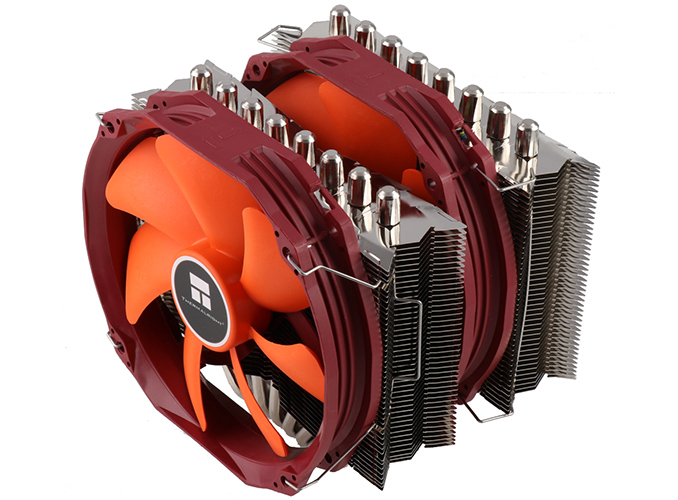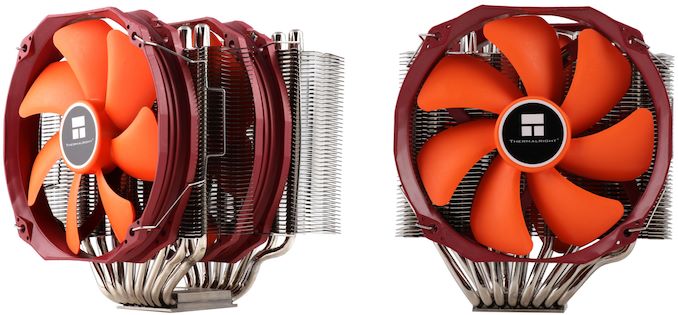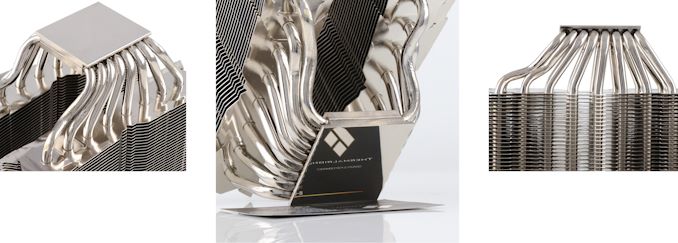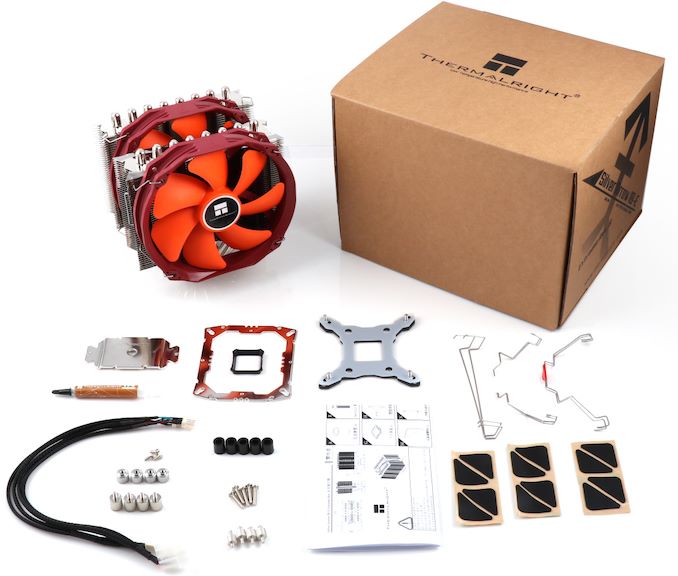Thermalright Silver Arrow IB-E Extreme Rev. B: An Air Cooler for 320 W
by Anton Shilov on March 22, 2019 4:00 PM EST- Posted in
- Cases/Cooling/PSUs
- AMD
- Intel
- Cooler
- Thermalright
- HEDT
- AM4
- LGA2066

Announcements of new high-performance air CPU coolers tend to get rare these days. On the one hand, many enthusiasts switched to closed loop liquid coolers in the recent years, which is why the market of high-end air coolers shrank. On the other hand, existing models of ‘mega coolers’ are powerful enough for the vast majority of CPUs. Nonetheless, makers known primarily for oversized air coolers continue to perfect their offerings. This week Thermalright introduced its Silver Arrow IB-E Extreme Rev. B giant air cooler that can dissipate up to 320 W of heat.
The Thermalright Silver Arrow IB-E Extreme Rev. B is a giant symmetric twin-tower cooler made of aluminum with a nickel-plated copper base, 2×45 aluminum fins as well as eight U-shaped 6-mm nickel-plated heat pipes. The heatsink measures 155×103×163 mm and weighs 850 grams (100 grams more than the original one). When equipped with two Thermalright’s 140-mm TY-143 PWM fans that spin at up to 2,500 RPM to create a 130 CFM air flow, the weight of the cooling system increases to 1170 grams. Given such weight, the company supplies custom retention plates with the device. (Ian: It still doesn't come close to my 2 kg Thermalright TRUE Copper heatsinks! :D)
The manufacturer claims that the Silver Arrow IB-E Extreme Rev. B has a 44 mm clearance between the base and the fins, which maximizes compatibility with memory modules. Speaking of compatibility, it is necessary to note that the cooler comes with retention plates for AMD’s AM4 as well as Intel’s LGA 775/115x/1366/2011-3/2066 sockets. Essentially, the new version has gained support for HEDT processors that come in Intel’s LGA2066 packaging, something that the previous-gen Silver Arrow IB-E Extreme cooler lacked.
As Thermalright positions its products primarily for performance-minded enthusiasts and overclockers generally not interested in 'extreme' modding, the Silver Arrow IB-E Extreme Rev. B does not feature any RGB lights. It still looks pretty cool with an orange fan.
| The Thermalright Silver Arrow IB-E Extreme Rev. B | ||
| General Specifications | ||
| CPU Socket | AMD: AM4 Intel: 775/115X/1366/2011/-3/2066 |
|
| Heat Sink Material | Dual tower heatsink, 2×45 aluminum fins, 8 heatpipes | |
| Dimensions (heatsink) | 155 × 103 × 163 mm | |
| Fan Dimensions | 152 × 140 × 26.5 mm | |
| Fan Speed | 600 ~ 2,500 RPM +/- 10% | |
| Fan Air Flow | 31.4 ~ 130 CFM | |
| Fan Air Pressure | 0.32 - 3 mm H20 | |
| Fan MTTF | ? | |
| Fan Connector | 4-pin | |
| Fan Power Consumption | 7.2 W | |
| Warranty | ? | |
| MSRP | $100 (?) | |
Thermalright did not touch upon pricing of the Silver Arrow IB-E Extreme Rev. B cooling system. Keeping in mind that the new cooler has many similarities with its direct predecessor, it is reasonable to expect it to carry a similar price tag of around $100+.
Related Reading:
- Alpenföhn Unveils Olymp: A Giant Air Cooler Rated for 340W TDP
- The MasterAir MA621P TR4: CM's Triple Fan Tower Cooler for Threadripper
- CES 2019: Deepcool Unveils 280W Capacity Assassin III Air Cooler
- Cooler Master Launches Wraith Ripper Cooler for Threadripper 2 CPUs
- Scythe Announces Mugen 5 CPU Cooler: New Design, Fan and Mounting
- Arctic Announces the Freezer 33 TR: An Air Cooler Designed for AMD’s Threadripper
Source: Thermalright














29 Comments
View All Comments
tamalero - Friday, March 22, 2019 - link
and what happened with the threadripper variants that were promised?KateH - Friday, March 22, 2019 - link
LGA 775 support? up to 320W? finally a beast that can handle an overclocked Pentium D!Samus - Sunday, March 24, 2019 - link
Ohh the days of PreshottDeath666Angel - Sunday, March 24, 2019 - link
I kinda missed those. Had a friend who had a P4 (prebuilt Aldi computer or something), but I was rocking self built Athlon XPs (1800+ OCed to 2200+ and then some X2's). Much cheaper and pretty comparable in performance, I think. Didn't need any fancy cooling either, just some Arctic Cooling 64 92mm tower cooler thingy.Samus - Monday, March 25, 2019 - link
It's funny how AMD has come full circle and essentially has the more efficient architecture again.And the great thing about CPU coolers, like cases, they don't really age-out technologically. There have been no real breakthrough in thermal cooling or case design (I'd argue the later has actually declined in quality over the last decade) so that stuff just keeps getting reused. I'm still rocking a 12 year old Silverstone FT01, and the only upgrade I've done to it is the USB 3.0 port replacement on the top. And like others here, I'm still running an ancient Thermalright tower cooler with a 120mm fan.
mode_13h - Monday, March 25, 2019 - link
Regarding breakthroughs, there was that "Sandia" cooler from years ago. I guess it got mired in some legal fight, with some business school boys who sold it without actually owning the rights to it.I was also hopeful about 3D vapor chambers, but I guess those haven't really caught on. I think this guy could use a vapor chamber - especially since it doesn't even have direct-touch heatpipes.
dromoxen - Tuesday, March 26, 2019 - link
iirc they produced a sandia cooler and it was reviewd by Linus torvalds on Youtube .. found to be very inadequate. Noctua FTW lx65w on 8600kmode_13h - Tuesday, March 26, 2019 - link
Thanks. I guess I do remember reading about that. Here's the vid you're talking about (and it's Linus Sebastian - Linus Torvalds is the Linux kernel creator/maintainer):https://www.youtube.com/watch?v=oCghRn2Zae4
IMO, that was not the best possible implementation of the idea. For one thing, what the heck is that thing on the bottom that he pries off at 1:10? Considering how far the heat has to travel to get into any of the fins (static or moving), I'll bet that thing would work so much better with a vapor chamber in the base.
Anyway, speaking of vapor chambers, I think top-end CPUs should use them (similar to high-end GPUs), instead of the current type of heat spreaders. If they could somehow build a vapor chamber where the die would literally form the bottom half of it, that would be far more efficient than even using solder to attach a conventional IHS. Pair that with direct-touch heat pipes and you could certainly dissipate 320 W on smaller air coolers than this.
flyingpants265 - Sunday, March 31, 2019 - link
That's called a scamAshinjuka - Friday, March 22, 2019 - link
I'd be interested to see some testing of these styles of multi-fan coolers with variation of the fan placement. My gut tells me that having a single fan in the middle of the 2 arrays of fins would be optimal, with it pulling air through the front fins and pushing it through the back without the need of a 2nd fan. Anyone know of an article out there testing this sort of thing?